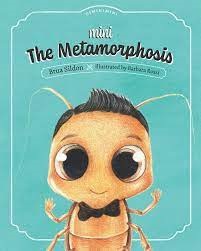
Ethiopian-British writer Lemn Sisay’s life is perhaps as strange as intriguing as that of Gregor Samsa, the main character in Franz Kafka’s tragic and classic short novel called “Metamorphosis”. Unlike Gregor Samsa, Lemn’s was born in Lancashire in 1967 and was adopted by British foster parents, where he grew up after coming to the UK with his mother while she was still pregnant of him. His mother came to Britain after his father, Giddey Estifanos, who was a pilot for Ethiopian Airlines, was killed in a plane crash in 1972. After giving birth to Lemn, his mother continued her studies while he was raised by foster parents.
His official biography in Wikipedia portrays him as, “a British author and broadcaster who was the official poet of 2012 London Olympics, chancellor of the University of Manchester from 2015 until 2022 and joined the Funding Museums board of trustees two years later having previously been appointed one of the museum’s fellows. He was awarded the 2019 Pen Pinter Prize. He has written a number of books and plays.”
In this brief Wikipedia biography of the writer, Lemn Sissay was not mentioned as an Ethiopian-British writer or as a British author of Ethiopian origins. I have no idea what British law says about what nationality people of African origin should take. Whatever the case might be, Lemn should at least be referred to as a British author with Ethiopian roots or as an Ethiopian- British writer. This is, however, my personal opinion and I have no objection against the nationality given or adopted by writers of African descent.
Let us go back to Lemn Sissay’s adoption of Metamorphosis as a stage drama. “Franz Kafka’s The Metamophosis is about Gregor Samsa, a traveling salesman who wakes up one day to find that he has transformed into a giant insect. His family is disgusted with him, especially when he is no longer able to earn an income. Gregor eventually dies after deciding that he is a burden to his family.”
According to a summary of one literary analysis of the short novel suggests that, “The Metamorphosis explores the degradation and transformative power of alienation, as its protagonist, Gregor Samsa experiences personal alienation from the people he has cared for and served, he is transformed, losing himself altogether.” Alienation is therefore the most dominant theme in the novel
Why Lemn Sissay chose to turn this story into a stage drama? What inspired him to do so? Is it based on his personal experience? Is it because of the alienation he faced while growing up in British society? A recent article in The Guardian newspaper apparently provides the answer to this question by quoting Lemn’s idea as the headline to the article. The article is entitled: ‘This Family is being devoured’ Lemn Sissay on why Kafka’s Metamorphosis is a tale for our times.” Lemn explains why this story of family meltdown is all about modern life. He is quoted as saying that, “Under pressure, we turn on each other-or something snaps,” he is quoted as saying.
Kafka’s absurdist tale, whose protagonist is unable to go to work due to his sudden shocking metamorphosis, is very much a story of today. This is about modern living and an economic system which invites you into debt and then squeezes you. The moment you can’t pay it back, you’re not worth anything. Gregor is dealing with the pressure to provide for his family but also to repay debt, according to Lemn and director Graham in the Guardian article.
What the Wikipedia biography about Lemn has omitted, namely his background, the Guardian article mentions it in the above-quoted article by saying that, “Sissay, who is of Ethiopian heritage and has spoken about his experience of growing up in Britain’s care system, thinks the story is much about pressures on the family, economic and otherwise.” Although Sissay does not speak of his personal experience in foster home where he grew up as alienation comparable to the one portrayed by Kafka in the novella, he reflects on present day British family life with a scathing criticism when he says that, “It’s happening now. More kids are going into care. People are having trouble to provide care for their family members.”
Maybe there is also a universal dimension to Kafka’s Metamorphosis in the parallel sense with the classic drama American playwright Arthur Miler entitled, “Death of a Salesman”. The play was premiered in Broadway in 1949 and is about a travelling salesman called Willy Loman who is despondent with his life and appears to be slipping into senility. However, the main protagonist in Death of a Salesman also dies at the end of the play. The two deaths may look different as far as their causes are concerned. However, there is a thin thread uniting both of them and that is the suffering they faced as a result of alienation.
Willy Lolan kills himself because life was too much for him and he was on the verge of mental collapse due to his illusion and misunderstanding of the American Dream and its work ethic. “The play also explores his relationship with his wife, his sons and his acquaintances.” According to another analysis of the play, “The American Dream equates success with being well-liked. Likability is an important quality for a salesman like Willy, yet he is unable to achieve the success he desires.”
In the case of both Gregor Samsa death comes after he faced a personal crisis that is beyond his control, i.e. his transformation into an insect. Thus the element of alienation is present in various degrees. In the case of Samsa, alienation is complete because of circumstances beyond his control while in the case of Willy Lonan his crisis is caused because of his failure to enjoy the respect he was expecting from his employers and society at large in his wrong conception of the American Dream.
The two plays are set in different times and environment and yet we can realize that both salesmen lose their lives because they are unable to practice their trade and live their dreams. This is a common or unifying theme running through both dramas and hence the universal character of their alienation. The two men struggle to get out of the impossible situation they were facing by adopting death as a final solution out of their crises. In a way, they are rejected by their families and then by society at large. Both of them are social failures because one of them fails to live up to his family’s expectations while the other fails because of wrong expectations from society.
Various interpretations were given to Arthur Miller’s Death of a Salesman, one of which was a psychoanalytical theory. “Psychoanalysis reveals that Willy’s decision is totally wrong because he is not able to face the problem so given the conclusion. Death is not the answer for his depression this drama ends with sadness because Willy did not believe himself to commit suicide.”
The situation is similar in both Death of a Salesman and Metamorphosis in the sense that both leading characters are the victims of guilt and self-alienation. “In the Metamorphosis, the symbolical transformation of a man into a bug signifies the repressed desires and the unconscious sense of guilt that worried him. The giant insect is the building up of the hidden expectations and desires that was disregarded by his father.”
Generally speaking, rewriting or changing a novel into a script for stage drama is a daunting task. A novel is written to be read by individuals but theatre is something that can be seen more vividly through the actions of the characters. The two plays, and the Metamorphosis requires a higher degree of understanding because it is a play based on an absurd event that needs reinterpretation while Death of a Salesman is a realistic play that can be easily understood and enjoyed by the audience.
There is a long tradition in Ethiopian theatre of translating foreign works into Amharic and staging them on local stages. The late poet laureate Tsegaye Gebremedhin is the quintessential Ethiopian translator of Shakespeare’s works and adopting foreign works like Bertolt Brecht’s Mother Courage to the local stage. The plays were enjoyed by the local audience because of their universal appeal and the central themes they were dealing with.
My hope is that one day; someone will take up the task of translating or rewriting The Metamorphosis for the local stage. That would also invite theatre goers to think profoundly about universal themes like guilt and family crisis that not unusual in Ethiopian society which is generally fond of tragic dramas.
It would be best if Lemn Sissay could do this job if his m his mastery of Amharic is commensurate to the task. Or it could be done in collaboration with local script writers. That could provide a good opportunity to challenge Ethiopian stage actors, producers and script writers and also the audience with something unconventional. That would also introduce every one with what absurdist drama is and how it can be done in a tradition that was born and grew up in realistic or naturalistic drama.
BY MULUGETA GUDETA
THE ETHIOPIAN HERALD WEDNESDAY 20 SEPTEMBER 2023





